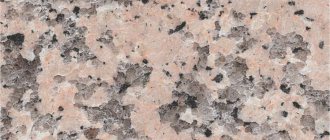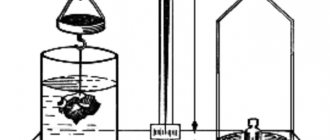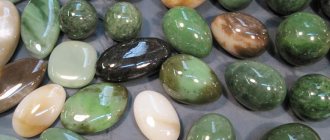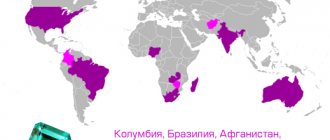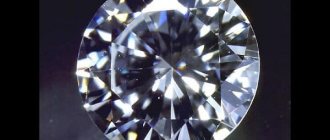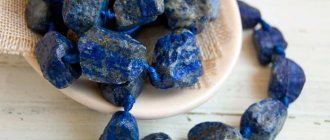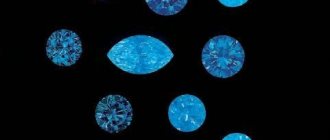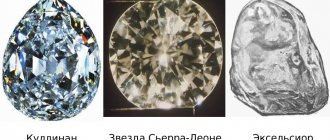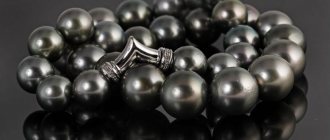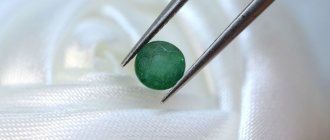The mineral hardness scale or Mohs mineralogical scale is compiled from reference samples according to the degree of relative hardness from 1 to 10. A qualitative ordinal indicator of the strength resistance of minerals included in this scale is determined by scratching. The mechanical ability of harder materials to scratch softer rocks determines the relative hardness of a particular type of mineral.
The 10 Mohs mineral elements are presented as reference samples and arranged in ascending order, allowing you to visually determine which mineral is harder. For example, talc occupies the first position in the table and is considered the softest among others presented on the scale. On the other side is a diamond, which, according to the “mineral strength” criterion, occupies the very top, that is, the 10th position on the Mohs scale and has no analogues in nature in terms of this indicator.
Methods for measuring hardness
The degree of strength of a material is assessed by pressing a stronger object into it, as well as grinding and scratching its surface. The choice of which scale to measure the hardness of minerals is large. Besides leaving a groove with Mohs reference crystals, there are 6 main measurement methods:
- Rockwell scale - the depth of penetration of an identifier with a diamond tip into the material is recorded. Applicable to metals and alloys.
- Shore hardness is determined in the same way. Additionally, the method allows you to study the strength of plastic and elastic objects.
- The Knoop scale works on the principle of indentation. The result is assessed in Knoop units: diamond – 8500, corundum – 2000.
- Rock hardness using the Schreiner method is quantitatively determined by the ratio of the load on the punch to the die area. The measurement is accompanied by drawing a deformation diagram.
- The Rozival scale is based on the example of the Mohs table: indicators for a number of minerals were obtained using a hardness tester based on the results of grinding samples. The complexity of the method did not allow it to displace the classics.
- A Vickers pyramid reinforced with diamonds is statically pressed into the test object, and the result is viewed from the area of the indentation through a microscope. The devices are called hardness testers (for example, PMT-3).
All accurate methods for finding strength are inferior to the quick tabular method of determining by comparing the strength properties of minerals. It is not always necessary to see the breaking load; in most cases, it is enough to know which stone is harder.
Rock Density
Mineralogists determine the type of stone by density and hardness. When excavating deposits, the second method proposed by F. Moos is used.
The type of stone is determined by a consistent assessment of its hardness, shine, fracture surface, color, color of the line (mineral powder), and other qualities.
The density of a stone is the ratio of its weight to the mass of water of the same volume. Determined in laboratories by hydrostatic weighing or immersion in heavy water (saturated liquid HgI2BaI2).
Density is assessed on a 20-point scale. Stones with values of 1 and 2 always lie in the surface layers, and those with values above 10 are located in the depths of the deposits. The latter include diamond, sapphire and ruby corundum, and other precious minerals.
The hardness of a stone is the degree of its resistance to mechanical damage. To find out, the found mineral is scratched, squeezed or pressed onto a small area.
What does hardness depend on:
- crystal cleavage;
- internal integrity of the mineral;
- percentage of quartz;
- type of secondary impurities;
- origin of the stone (how it was formed).
Less hard stones are those whose crystals are weakerly welded together, have more loose impurities, and have cracks or other defects inside. The Mohs method is used to evaluate the approximate cleavage, species, and durability of the gem.
By comparing the relative Mohs scale readings with the minerals they find, geologists understand the best way to mine the rock. Jewelers use these same values to select tools for polishing and cutting. Sellers and buyers of gems determine its authenticity, durability and care methods.
Graduation principles from Mohs
A system for comparing the hardness of crystals was invented by the German geologist Friedrich Moos (another version of the sound is Moss). It is a ten-point scale of reference minerals , arranged in order of increasing strength.
When you try to scratch one crystal with another, a chain is built from the softest stone (talc) to the hardest (diamond). The Mohs hardness scale only informs about the comparative strength of the minerals being compared.
If the test stone does not leave a mark on the quartz face, and the standard does not scratch the sample, then it can be stated that the hardness of the crystal being tested is equal to 7 on the Mohs scale table.
| Control mineral | Number according to the identifier | Other stones of the same strength | Scratching object | Cutter hardness value |
| Soapstone | 1 | Graphite | Nail | 2,5 |
| Gypsum (selenite) | 2 | Halite, mica, chlorite | ~ | ~ |
| Calcite (Iceland spar) | 3 | Biotite, silver, gold | Copper coin | 3,5 |
| Fluorite (fluorspar) | 4 | Sphalerite, dolomite | Iron knife, window glass | 5,5 |
| Apatite | 5 | Lapis lazuli, hematite | ~ | ~ |
| Orthoclase (adularia, feldspar) | 6 | Opal, rutile | Steel nail | 6,5 |
| Quartz (agate, jasper, amethyst, rock crystal, aventurine) | 7 | Tourmaline, garnet | Pobedite drill | 8,5 |
| Topaz | 8 | Aquamarine, emerald, spinel | ~ | ~ |
| Corundum (sapphire, ruby) | 9 | Wolfram carbide | Diamond | 10 |
| Diamond | 10 | Elbor | ― | ― |
For ease of use, the reference mineral is fixed to the end of the tube with epoxy glue. Scratch carefully, trying not to damage the sample. They work in the same way with improvised objects. Since the hardness of glass on the Mohs scale is in the middle position (between values 5 and 6), the test begins with scratching its surface.
Hardness in drinking water
The term water hardness refers to the amount of dissolved and undissolved salts present in natural water deposits. The water may be too soft or too hard. Both options are harmful. A lack of salts disrupts the water-alkaline balance in the body; an excess causes multiple diseases of important organs: the heart, kidneys, skin, and liver. If there is an excess of salts, the liquid has a bitter metallic taste, may be cloudy, with different color shades.
Compliance with drinking water hardness standards is very important for consumers. Salts can cause poisoning; they cause stomach upset, yellowing of the skin, and other troubles. A high concentration of hardness salts negatively affects the operation of household appliances - impurities form difficult-to-clean scale and rocky lime deposits. Because of them, slag is formed in the water supply system, and household/industrial appliances, plumbing, and hydraulic equipment quickly fail.
Table with comparison scale
Comparison of the strength characteristics obtained using various methods with the Mohs table is useful in the practical use of stones. Absolute values of hardness are determined by other estimates; a comparison of the criteria can be seen in the table.
| Minerals and rocks | Mohs grading | According to Schreiner, MPa | Strength on the Knoop scale, units | Grinding hardness in water according to Rozival | Strength according to microhardness tester PMT-2, PMT-3, kg/mm² |
| Talc | 1 | 250―400 | 12 | 0,03 | 2,4 |
| Gypsum | 2 | 32 | 1,25 | 40 | |
| Calcite, marble, anhydrite | 3 | 950―1400 | 135 | 4,5 | 110 |
| Fluorite, dolomite | 4 | 2500―3200 | 160 | 5 | 190 |
| Apatite, granite | 5 | 3000―3700 | 400 | 6,5 | 530 |
| Orthoclase, basalt | 6 | 3900 | 500 | 37 | 790 |
| Quartz, diabase | 7 | 6300 | 1250 | 120 | 1120 |
| Topaz | 8 | 1550 | 175 | 1430 | |
| Corundum | 9 | 1900 | 1000 | 2060 | |
| Diamond | 10 | 8300 | 140000 | 10060 |
The reason for the hardness of granite lies in its complex mineral composition, where the main components, quartz and mica, are classified into different categories - 7 and 2. Their quantitative ratio determines the properties of the rock.
The Mohs scale is also used to compare the hardness of metals - this is convenient when choosing a setting for a precious stone.
| Name | Tin | Gold Silver | Copper, bronze | Nickel | Platinum | Palladium | Titanium | Tungsten |
| Value by gradation | 1,5 | 2,5―3 | 3 | 4 | 4,5 | 4,7 | 6 | 7,5 |
The table shows which metals can scratch others. This circumstance is important to consider when storing jewelry together.
How to determine water hardness
It is very difficult to determine by touch whether water is hard or soft. The term “stiffness” arose because after washing fabrics lose their softness, wooliness or silkiness, and become unpleasantly hard to the touch. Weaving or knitting weaves, regardless of density, have a porous structure. Salts are added to the fibers, which makes things rougher, tougher, and denser after washing.
You can determine water hardness both in the laboratory and at home. The presence of hardness salts can be determined visually:
- The drinks have an unpleasant bitter taste.
- Teas take longer to brew than usual.
- When cooked, the meat becomes unpleasantly tough.
- Salt deposits are noticeable on the walls of the dishes.
- A large amount of scale forms on the appliances.
- A whitish residue remains on the hair after washing and on the comb.
- Soap and powder do not foam well, and their consumption increases during washing.
Increased hardness of drinking water can cause damage to health and heating appliances. Without knowing the exact salt concentration indicators, it is difficult to calculate the dose of anti-scale agents for washing and drying units or program a coffee machine for cleaning. It is difficult to ensure a comfortable life for fish in an aquarium or to choose the right cleaning filters. In addition to visual assessment, it is better to use more accurate measuring methods for determining the hardness of drinking and industrial water.
Water hardness measurement
Before consumption, before watering the garden, before supplying water to pipelines or before technical use of water for production processes, it is useful to check for the presence of hardness salts. Such a check will eliminate consumer claims against water supply companies and extend the life of expensive industrial equipment.
To measure water hardness, household and professional instruments are used:
- Medical strips sold in pharmacies give good results with an accuracy of 1-2°F.
- Express tests for an aquarium allow you to monitor the water supply to containers with aquatic inhabitants or check solutions intended for watering plants.
- Salinity meter, spectrum analyzer, TDS and EC meter show salt content and other parameters: electrical conductivity, solution resistance.
It is helpful to order a test from a laboratory to obtain accurate results with supporting documentation. Then you don’t have to think about how to determine water hardness, you don’t need to buy measuring instruments or calculate indicators based on indirect parameters using formulas.
How to determine water hardness using the formula
You can determine water hardness using the formula. To determine the general indicators, you need to perform the following calculation:
Jo = [Ca2+] + [Mg2+] = (m(Ca2+))/(E(Ca2+) x V(H2O)) + (m(Mg2+))/(E(Mg2+) x V(H2O)),
Where:
[Ca2+]; [Mg2+] is the concentration of calcium and magnesium ions, in mEq/dm3;
m(Ca2+); m(Mg2+) - ion content in mg;
V(H2O)—volume of water, dm3;
E is the equivalent mass of ions* (its values have already been given in the text: Ca2+ = 20.04; Mg2+ = 12.16 mg/lil g/mol).
The calculated result is obtained in units: mg-eq/dm3.
Next, temporary or permanent stiffness is calculated. The calculated value is subtracted from Zh and the values of all three categories of J are obtained.
Carbonate FA is calculated using the formula:
Lc = [HCO3-] = (m(HCO3))/(E(HCO3) x V(H2O))
Non-carbonate: Zhk = Jo-Zhk.
Strength values of precious minerals
The hardness test is good for distinguishing rare beautiful crystals from their glass or artificial imitations. Precious stones include natural minerals in natural or processed form - diamonds (diamonds), sapphires (blue), rubies, emeralds, alexandrites.
Synthetic analogues of precious stones are grown under special conditions . Such gems are much cheaper. Unscrupulous manufacturers make jewelry from artificial crystals or jewelry glass of the required color, and then offer them at the same prices as natural ones. A well-known imitation is cubic zirconia. It is very similar to a diamond, but its cost is not comparable to natural stones. to detect a fake by finding the Mohs hardness:
- when a sapphire has a value of 7, then there is a high probability that the cabochon is made from quartz;
- If in a diamond’s passport the strength index is 8.5, but it should be 10, it becomes clear that this stone is not of natural origin (cubic zirconia has an index of exactly 8.5).
Sometimes an argument is given to prove that a crystal is natural: it scratches the glass. But you need to know that jewelry glass also leaves a mark on ordinary glass. The table shows values for some stones.
| Crystal | Mohs hardness | Crystal | Mohs hardness |
| Ruby | 9 | Agate | 6,5―7 |
| Alexandrite | 8,5 | Jasper | 6―7 |
| Spinel | 8 | Amazonite | 6―6,5 |
| Topaz | 8 | Nephritis | 6―6,5 |
| Aquamarine | 7,5―8 | Rutile | 6―6,5 |
| Beryl | 7,5―8 | Rhodonite | 5,5―6,5 |
| Pyrope | 7,5―8 | Obsidian | 5―5,5 |
| Tourmaline | 7,5―8 | Purpurite | 4,5 |
| Zircon | 6,5―7,5 | Corals | 3―4 |
The Mohs hardness scale, despite the relative results, remains the main tool in geological surveys. In the field, every kilogram of weight carried is recorded, and to identify an unknown rock sample, a simple knife and glass is enough.
Information on the hardness of minerals in most reference books is given in relative values. A narrow circle of specialists is interested in absolute values. Another area of primary use of the Mohs scale is jewelry making. Based on the hardness of the crystals, they choose the method of processing the stone, the grinding option and the machines and tools needed for this.
Notes
The scale allows you to estimate the strength of the material only approximately and compare samples with each other.
Variable value
invented by Mohs does not take into account the layered structure of some stones and differences in rock cleavage. Therefore, when different areas of the same mineral are damaged, hardness indicators may differ.
Important! Even the direction of the scratch can affect the final result. Thus, obsidian has an index of 5–5.5, it depends on the different state of the mineral.
The indicator is affected by impurities in the gem and variations in the orientation of the crystal lattice.
What is salt
The chemical formula of this substance is as follows: NaCl. Table salt is also called sodium chloride or rock salt. When crushed, this food product appears as colorless crystals. The latter may have different sizes. In any case, salt in bulk is white.
The main feature of sodium chloride, as is known, is its characteristic taste. In everyday life and in the food industry, table salt can be added to a variety of products. As scientists have found out, sodium chloride is a substance without which human life is completely impossible.
Solubility degree
The peculiarities of salt, among other things, include the fact that its solubility in water depends little on the temperature of the latter. This indicator for NaCl increases by 7 g from 0 to 100 °C. However, the solubility of the salt is significantly reduced if the water contains MgCl2 or CaCl2. This indicator increases sharply for NaCl with increasing pressure. The process of salt dissolution occurs with significant heat absorption. This substance is practically insoluble in alcohol.
